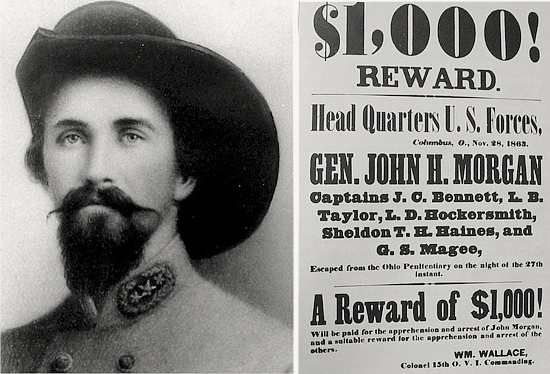Civil War: The arrival of John Hunt Morgan
As the Civil War unfolded a Confederate “rockstar” would emerge out west and create quite a stir upon his arrival in Richmond.

With his daring cavalry raids and flamboyant fashion sense, there’s no doubt that Confederate General J.E.B. Stuart was the “rockstar” of the Confederacy in the eastern theater of the war. His impact on the battlefield was only multiplied by the impact that his exploits had on Southern morale during the war. As the war unfolded, another Confederate “rockstar” would emerge out west and create quite a stir upon his arrival in Richmond among the city’s population. His name was John Hunt Morgan. Morgan grew up in Kentucky, and despite the state’s initial neutrality (and later siding with the Union), he joined the Confederate Army in 1861 and saw much success during the early years of the war. His impending arrival was heralded in The Richmond Whig:
GEN. MORGAN. – We are informed that Gen. John H. Morgan will arrive in Richmond from Danville, on Tuesday evening. He will meet with a grand reception from our citizens, and be escorted from the depot to the Spotswood Hotel by a regiment of Confederate troops. 1/2/1861
“Grand reception” was putting it a little lightly. When Morgan arrived in Richmond on January 7th, he was met by a large crowd of cheering citizens. He was presented with gifts and poems written in his honor along with requests for his autograph and locks of his hair. He was met by his fellow “rockstar” Gen. J.E.B. Stuart and his brother-in-law Gen. A.P. Hill. Morgan addressed the crowd, saying, “Fellow citizens, I thank you for this reception and hope that my future career will prove that I am not unworthy of the honor you have done me.”
Morgan was in town to petition the Confederate war department to give him a new command. This was complicated by the fact that while Stuart generally stayed in the good graces of his superior officer, Gen. Robert E. Lee, Morgan most assuredly had not. General Braxton Bragg, his former superior officer, now served as a military advisor to Jefferson Davis, and the animosity between the two men ran deep.
Why the bad blood? Well, it all goes back to why the Southern public loved Morgan in the first place. Morgan’s claim to fame was his raids into Kentucky, where he attacked Union supply lines and made significant progress in disrupting the delicate balance of Kentucky’s role as a border state. Morgan (and many others) believed that they could eventually dislodge Union forces from Kentucky and claim the state for the Confederacy. After two very successful raids and a promotion to brigadier general, he set off in June for his most famous raid, which would come to be known as “Morgan’s Raid.” Before departing, Bragg gave Morgan specific orders not to cross the Ohio River, knowing his tendency for aggressive action. So what did Morgan do? He crossed the Ohio River into Indiana and eventually Ohio, causing mayhem and panic throughout both states. Union Gen. Ambrose Burnside quickly adjusted and sent his army to meet the new threat from Morgan. After a handful of skirmishes and weeks of pursuit, Morgan’s entire command was eventually captured and taken prisoner in Ohio.
Not content to let imprisonment slow him down, Morgan and a handful of his officers escaped from prison in Ohio by digging a tunnel out of a jail cell and climbing one of the outer walls. After hopping railroad cars and crossing the Ohio River, Morgan made it safely back to Confederate territory. Even though the daring raid and Morgan’s escape made headlines and galvanized the Southern public, the value of Morgan’s Raid was questionable at best and a waste of resources at a time when the Confederacy couldn’t afford to be reckless. But what a story it made–and Richmonders ate it up.
Unfortunately for Morgan, his superiors at the War Department did not feel the same enthusiasm for his exploits. Bragg felt Morgan was a better candidate for a court-martial than a new command, and Secretary of War John Seddon was inclined to agree. A court-martial was never filed, but it was clear that Morgan wouldn’t leave Richmond with a new command. He departed Richmond shortly after and returned later in the spring to press the issue once more. Finally, the War Department relented, and Morgan was given command of Confederate forces in eastern Tennessee, where he renewed his raids into Kentucky but never with the same success and vigor of his earlier campaigns. He would only live another nine months after his January visit to Richmond. In September, he would be shot and killed in a surprise Union attack in Greeneville, TN.
-
Recommend this
on Facebook -

Report an error
-

Subscribe to our
Weekly Digest




There is 1 reader comment. Read it.